Your Call?
Was combining two lousy images to come up with a single very pleasing one kosher or not kosher for you? Why or why not? Right or wrong?
My Call
In the last blog post, most folks preferred the larger in the frame image of the skimmer with the spearing. David Pugsley and I preferred the smaller in the frame image, #1. Why? Because of the lovely beach vegetation, the Shallow Depth of Field/Diminishing Sharpness Perspective, and the o-o-f strip of green at the top. In short, because of the subtly beautiful habitat and the soft light.
What’s Up?
Please note as seen below that San Diego ain’t just pelicans. You will be seeing some great San Diego Wood Ducks here soon and lots more. Scroll down for info on joining me there.
With only a two hours plus drive to the Lorton, VA Auto Train station, I slept in on Saturday morning and got some work done. After almost missing the train on the way up, I made sure to arrive plenty early for the return trip. I had an early dinner on the train and then spent several hours doing third edits on several big trip folders to make some more room on my 8TB SSD. I need to stay well below 4TBs of images as my backup drives are only 4TB. Right now, I have 5.56TB available out of 8TB. I’d like to get to 6TB available before I get to Iceland next week.
I woke early on Saturday and spent several hours working on the flight guide that I am doing with Arash Hazeghi. Today is Sunday 2 July 2023 and I will be doing the same thing today and do some pre-packing photo gear planning for the upcoming Grimsey trip. Wherever you are, and whatever you are doing, I hope that you too have a great day.
Please remember to use the B&H and Amazon links that are found on most blog pages and to use the BIRDSASART discount code at checkout when purchasing your new gear from Bedfords to get 3% back on your credit card and enjoy free second-day air FedEx. Please, also, consider joining a BAA IPT. You will be amazed at how much you will learn!
You can find some great photo accessories (and necessities, like surf booties!) on Amazon by clicking on the Stuff tab on the orange/yellow menu bar above. On a related note, it would be extremely helpful if blog-folks who, like me, spend too much money on Amazon, would get in the habit of clicking on the Amazon logo link on the right side of each blog post when they shop online. As you might expect, doing so will not cost you a single penny, but would be appreciated tremendously by yours truly. And doing so works seamlessly with your Amazon Prime account.
If an item — a Delkin flash card, or a tripod head — for example, that is available from B&H and/or Bedfords, is also available in the BAA Online Store, it would be great, and greatly appreciated, if you would opt to purchase from us. We will match any price. Please remember also to use my B&H affiliate links or to earn 3% cash back at Bedfords by using the BIRDSASART discount code at checkout for your major gear purchases. Doing either often earns you free guides and/or discounts. And always earns my great appreciation.
The Fact$ of Life
The market for editorial sales of natural history images has virtually disappeared. The incomes of the world’s top stock photographers are down by at least 90%. Like me, most depend on income from photo trips, the sale of educational materials, and income from this or that affiliate program.
In 2001, BAA sold the publication rights to images for nearly one-quarter million US dollars. That amount dropped to about $20,000 by 2011, and in 2017, to slightly more than $2,000.00. We’ve stopped counting. IPTs used to fill within days. Now I am happy to go with one or two folks, but I’d much rather have you along. And so it goes. In 2009, I turned to creating educational blog posts, now to the tune of 4047. Yes, 4047 educational blog posts. So, please remember to use either my B&H or Bedfords affiliate links for your major purposes. It does not cost you one cent to do either.
B&H
Many folks have written recently stating that they purchased a Sony a1 from B&H and would like their free membership in the Sony 1 Info and Updates Group, a $150.00 value. When I check my affiliate account, their orders have not been there. When I let them know that they get credit for B&H purchases only if they use one of the many B&H affiliate links on the blog or begin their searches with this link, they are always disappointed. If in doubt, please contact me via e-mail and request a BH link. I am always glad to help and to guide you to the right gear.
B&H Simplified
To ensure that I get credit for your B&H purchases, you can always click here. The tracking is invisible but greatly appreciated. And, you can use your PayBoo card. You must use the website to order. Thanking me for the past 4000 educational blog posts could not be any easier and will not cost you one penny. Please shoot me your B&H receipt for major purchases.
Bedfords Simplified
Click here to start your search. Choose standard shipping, and when you get to the payment page, enter BIRDSASART in the discount code box and hit apply. You will automatically be upgraded to free second day air Fed-Ex and receive 3% cash back on your credit card once your order ships. Either is greatly appreciated by yours truly.
Money Saving Reminder
Many have learned that if you need a hot photo item that is out of stock at B&H and would like to enjoy getting 3% back on your credit card along with free 2nd Day Air Fed-Ex Air shipping, your best bet is to click here, place an order with Bedfords, and enter the coupon code BIRDSASART at checkout. If an item is out of stock, contact Steve Elkins via e-mail or on his cell phone at (479) 381-2592 (Central time). Be sure to mention the BIRDSASART coupon code and check the box for Free Shipping. That will automatically upgrade to free 2nd Day Air Fed-Ex. Steve has been great at getting folks the hot items that are out of stock at B&H and everywhere else. The waitlists at the big stores can be a year or longer for the hard-to-get items. Steve will surely get you your gear long before that. For the past year, he has been helping BAA Blog folks get their hands on items like the SONY a 1, the SONY 200-600 G OSS lens, the Canon EOS R5, the Canon RF 100-500mm lens, and the Nikon 500mm PF. Steve is personable, helpful, and eager to please.
Important Note
As an Amazon Associate, I earn a small percentage when you purchase from Amazon after using any of the Amazon links on the blog (including the logo-link on the right side of each blog post page). My affiliate link works fine with Amazon Prime and using it will not cost you a single cent. Huge thanks, BTW 🙂


Gear Questions and Advice
Too many folks attending BAA IPTs and dozens of photographers whom I see in the field and on BPN, are — out of ignorance — using the wrong gear, especially when it comes to tripods and more especially, tripod heads. And the same is true in spades when ordering new camera bodies or lenses. My advice will often save you some serious money and may help you avoid making a seriously bad choice. Please know that I am always glad to answer your gear questions via e-mail. If you are desperate, you can try me on my cell at 863-221-2372. Please leave a message and shoot me a text if I do not pick up.
|
|
|
This image was created on 22 January 2023 at La Jolla, CA. Standing at full height, behind the Robus RC-5558-3 Vantage Series 3 Carbon Fiber Tripod topped by the Levered-Clamp FlexShooter Pro, I used the Sony FE 600mm f/4 GM OSS lens and The One, the Sony Alpha 1 Mirrorless digital camera. ISO 2000. Exposure was determined via Zebras with ISO on the rear dial: 1/250 sec. at f/4 (wide open). AWB at 7:48:49am on a very cloudy morning. Tracking: Expand Spot/AF-C with Bird Face/Eye detection enabled was active at the moment of exposure and performed just fine. Be sure to click on the image to enjoy the hi-res version. Brandt’s Cormorant begging chick in nest/head of adult replaced |
Two Lousy Images Make One Wonderful Image
Frame _A1G1659 featured a perfect look at the head of the chick, but the adult was turned away. In frame _A1G1710, created 16 seconds later, the head angle for the adult was perfect, but the head of the chick was not as sharp and was turned away from the adult. I used _A1G1659 as the base image, painted a Quick Mask of the head of the adult in _A1G1710 (and made sure to include extra background), moved it onto the base image, fine-tuned the position, refined it via a Regular Layer Mask, and then, using the Divide and Conquer technique, eliminated the parts of the lower mandible and gular sack (from the base image) that were not covered by the Quick Mask. Note that I saved only two of the more than 50 images in the sequence. Be sure to check out the before and after animated GIF below.
Reducing the Angle of Declination
I often use the 70-200 II GM lens with either TC when working the nests at the Brandt’s Cormorant ledge. To reduce the angle of declination, I went with the tripod-mounted 600mm f/4. In simple terms, by going to a longer lens I did not have to point the lens down to the nests as steeply as I would have if I had been working with a shorter focal length — 280 or 400mm.
The Robus RC-5558 Vantage Series 3 Carbon Fiber Tripods
For reasons that I do not understand, the prices of both the 3-leg section Robus RC-5558-3 Vantage Series 3 Carbon Fiber tripod and the 4-leg section Robus RC-5558 Vantage Series 3 Carbon Fiber tripod have been drastically reduced. They are available only from B&H and are currently priced at a ridiculously low $399.95, about 1/3 the price of a comparable Really Wrong Stuff (RWS) tripod. Right now, the 3-leg section version is my go-to tripod.
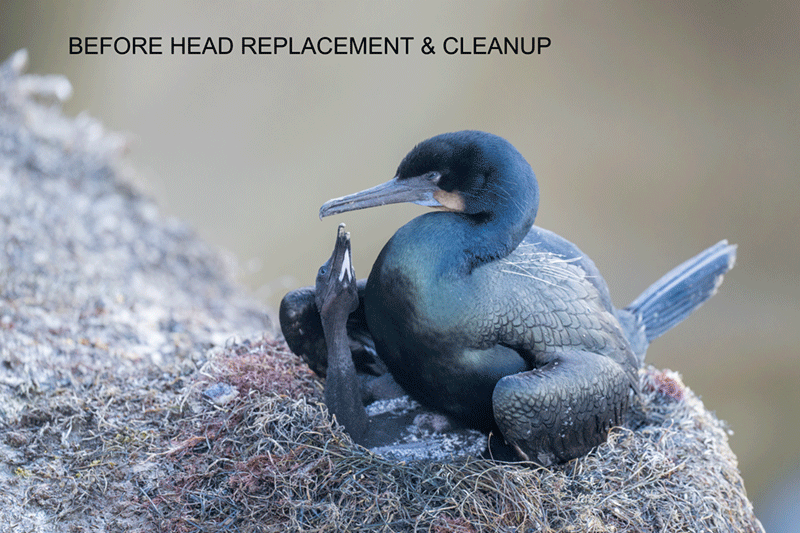
|
The Image Optimization
After converting the base image in Photoshop, I converted the source image, the one with the perfect adult head angle, using the identical settings. (Control click > Use Previous Settings.) Then I ran Topaz AI DeNoise on both using the Clear preset. Then I replaced the head of the adult on the base image as detailed above. Next, I cleaned up a single blemish on the nest using the Patch Tool, and the edges of the nesting shelf using the Clone Stamp Tool at 30% opacity. Then, for the first time ever, I did some Tail Doctor work.
To smooth out the repairs on the edge of the nesting shelf, a layer of Gaussian Blur — Radius: 64 pixels — was applied to the whole image and painted in where needed after applying a Hide-All (Inverse or Black) Layer Mask. The entire process took less than eight minutes.
|
|
The BIRDS AS ART Current Workflow e-Guide (Digital Basics II).You can order your copy from the BAA Online Store here, by sending a PayPal for $40 here, or by calling Jim or Jennifer weekdays at 863-692-0906 with your credit card in hand. Be sure to specify Digital Basics II. |
The BIRDS AS ART Current Workflow e-Guide (Digital Basics II)
The techniques mentioned above and tons more great Photoshop tips and techniques — along with my complete digital workflow, Digital Eye Doctor Techniques, and all my personalized Keyboard Shortcuts — are covered in detail in the BIRDS AS ART Current Workflow e-Guide (Digital Basics II), an instructional PDF that is sent via e-mail. Note: folks working on a PC and/or those who do not want to miss anything Photoshop may wish to purchase the original Digital Basics along with DB II while saving $15 by clicking here to buy the DB Bundle.
Please note: the Divide and Conquer technique was inadvertently omitted from DB II. It is detailed in the blog post here.
Folks who learn well by following along rather than by reading can check out the complete collection of MP 4 Photoshop Tutorial Videos by clicking here. Note: most of the videos are now priced at an amazingly low $5.00 each.
You can learn how and why I converted all of my Canon digital RAW files in DPP 4 in the DPP 4 RAW Conversion Guide here. More recently, I became proficient at converting my Nikon RAW (NEF) files in Adobe Camera Raw. About three years ago I began converting my Nikon and Sony RAW files in Capture One and did that for two years. You can learn more about Capture One in the Capture One Pro 12 Simplified MP4 Video here. The next step would be to get a copy of Arash Hazeghi’s “The Nikon Photographers’ Guide to Phase One Capture One Pro e-Guide” in the blog post here. Today, I convert my Sony raw files in Photoshop with Adobe Camera Raw.
You can learn advanced Quick Masking and advanced Layer Masking techniques in APTATS I & II. Save $15 by purchasing the pair.
The 2023/2024 San Diego Brown Pelicans (and more!) IPTs
San Diego IPT #1. 3 1/2 DAYS: WED 27 DEC thru the morning session on Saturday 30 DEC 2023. $2099.00. Deposit: $699.00. Limit: photographers.
San Diego IPT #2. 4 1/2 DAYS: TUES 9 JAN thru the morning session on SAT 13 JAN 2024: $2699.00. Deposit: $699.00. Limit: 6 photographers.
San Diego IPT #3: 4 1/2 DAYS: TEUS 23 JAN thru the morning session on SAT 27 JAN 2024: $2699.00. Deposit: $699.00. Limit: 6 photographers/Openings: 5.
Please e-mail for information on personalized pre- and post-IPT morning sessions.
Join me in San Diego to photograph the spectacular breeding plumage Brown Pelicans with their fire-engine red and olive green bill pouches; Brandt’s (nesting) and Double-crested Cormorants; breeding plumage Wood and Ring-necked Ducks; other duck species possible including Lesser Scaup, Redhead, Northern Shoveler and Surf Scoter; a variety of gulls including Western, California, and the gorgeous Heermann’s, all in full breeding plumage; shorebirds including Marbled Godwit, Willet, Sanderling and Black-bellied Plover; many others are possible including Least, Western, and Spotted Sandpiper, Whimbrel, Black and Ruddy Turnstone, Semipalmated Plover, and Surfbird; Harbor Seals and California Sea Lions (both depending on the current regulations and restrictions). And as you can see by studying the IPT cards, there are some nice bird-scape and landscape opportunities as well. Not to mention a ton of excellent flight photography opportunities and instruction.
I discovered some really neat new spots on my 2022/23 visit. As a result, the first and second IPTs may include an afternoon or two of landscape photography.
Please note: where permitted and on occasion, ducks and gulls may be attracted (or re-located) with offerings of grains or healthy bread.
|
|
|
San Diego offers a wealth of very attractive natural history subjects, including and especially the Pacific race of California Brown Pelican. With annual visits spanning more than four decades, I have lots of photographic experience there … Click on the composite to enjoy a larger version. |
Learning Exposure, Whether You Like It Or Not
Whether you like it or not, we will be beating the subject of exposure like a dead horse. In every new situation, you will hear my thoughts on exposure along with my thoughts on both Nikon and Canon histograms and SONY Zebras. Whether you like it or not, you will learn to work in manual mode so that you can get the right exposure every time (as long as a bird gives you ten seconds with the light constant). Or two seconds with SONY zebras … And you will learn what to do when the light is changing constantly. What you learn about exposure will be one of the great takeaways on every IPT.
|
|
|
Though the pelicans will be the stars of the show on this IPT, there will be many other handsome and captivating subjects in wonderful settings. Click on the composite to enjoy a larger version. |
It Ain’t Just Pelicans
With gorgeous subjects just sitting there waiting to have their pictures taken, photographing the pelicans on the cliffs is about as easy as nature photography gets. With the winds from the east almost every morning, there is usually some excellent flight photography, at times with 70-200mm lenses! And the pelicans are almost always doing something interesting: preening, scratching, bill pouch cleaning, or squabbling. And then there are those crazy head throws that are thought to be a form of intra-flock communication. You will be guided as to how to make the best of those opportunities. Depending on the weather, the local conditions, and the tides, there are a variety of other fabulous photo chances available in and around San Diego. Each IPT will include one or two duck sessions.
|
Did I mention that there are lots of great birds and natural history subjects in San Diego in winter? Click on the composite to enjoy a larger version. |
The San Diego Details
These IPTs will include four or five 3-hour morning photo sessions, three or four 1 1/2-hour afternoon photo sessions, and three or four working brunches that will include image review and Photoshop sessions. On rare cloudy days, we may — at the leader’s discretion, stay out in the morning for a long session and skip that afternoon shoot. To ensure early starts, breakfasts will be your responsibility. And so that we can get some sleep, dinners will be on your own as well. In the extremely unlikely event that Goldfish Point is closed due to local ordinance (or whimsy) — that has never happened in the past fifty years, I will of course do my very best to maximize our photographic opportunities.
|
|
|
San Diego offers a wealth of very attractive natural history subjects, including and especially the Pacific race of California Brown Pelican. With annual visits spanning more than four decades, I have lots of photographic experience there … Click on the composite to enjoy a larger version. |
Deposit Info
A $699 deposit is required to hold your slot for one of the 2023/2024 San Diego IPTs. You can send a check (made out to “BIRDS AS ART”) to us here: BIRDS AS ART, PO Box 7245, Indian Lake Estates, FL, 33855, or call Jim or Jennifer at the office with a credit card at 863-692-0906. Your balance, payable only by check, is due three months before the trip.
|
Variety is surely the spice of life in San Diego. Click on the composite to enjoy a larger version. |
Getting Up Early and Staying Out Late
On all BIRDS AS ART IPTS including and especially the San Diego IPT, we get into the field early to take advantage of unique and often spectacular lighting conditions and we stay out late to maximize the chances of killer light and glorious sunset silhouette situations. We often arrive at the cliffs a full hour before anyone else shows up to check out the landscape and seascape opportunities.
Typos
With all blog posts, feel free to e-mail or to leave a comment regarding any typos or errors.


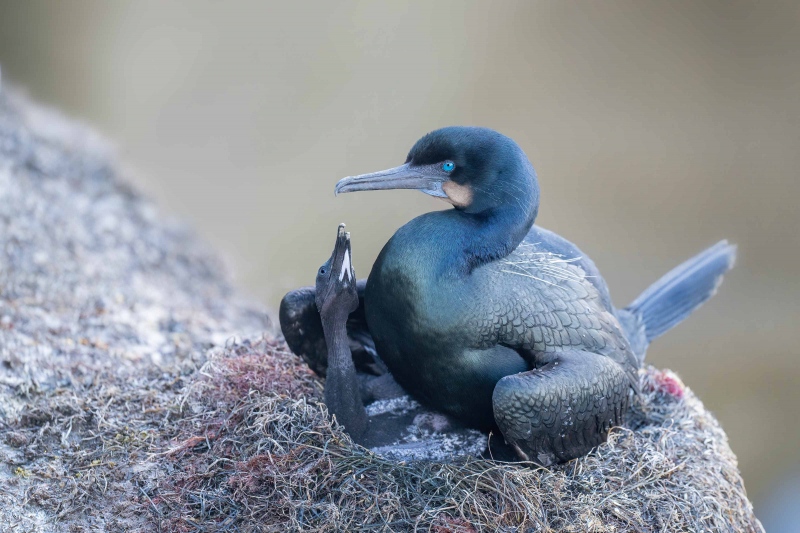

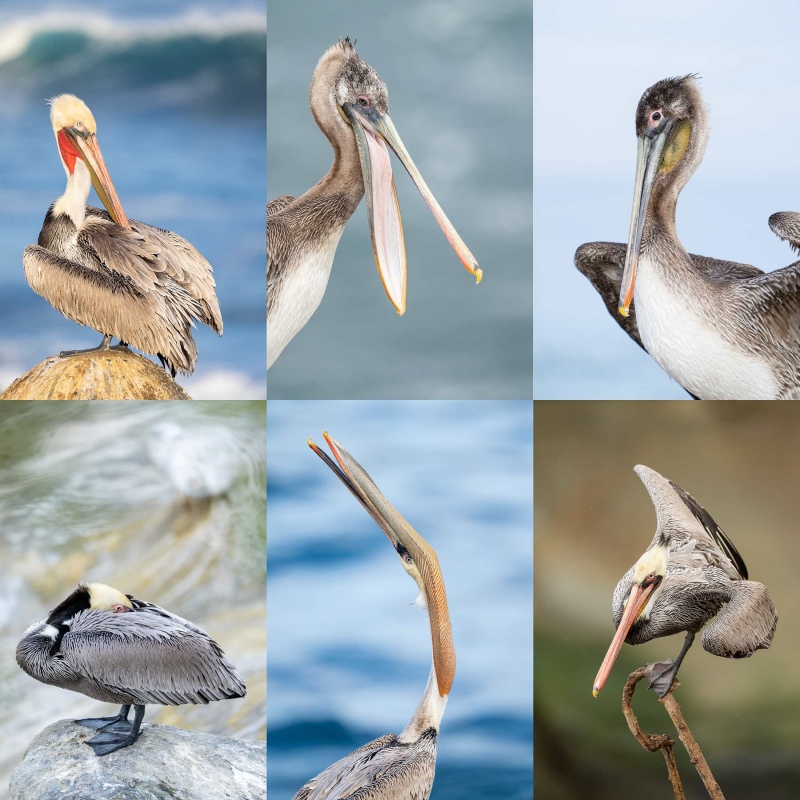
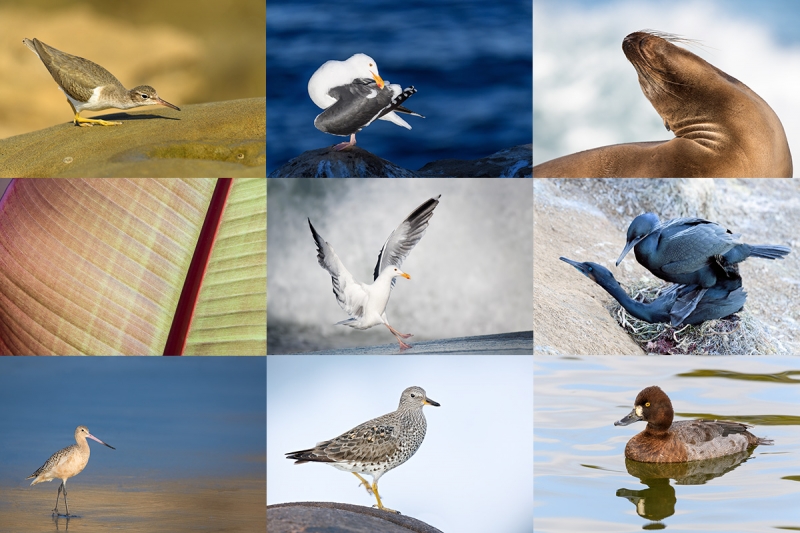

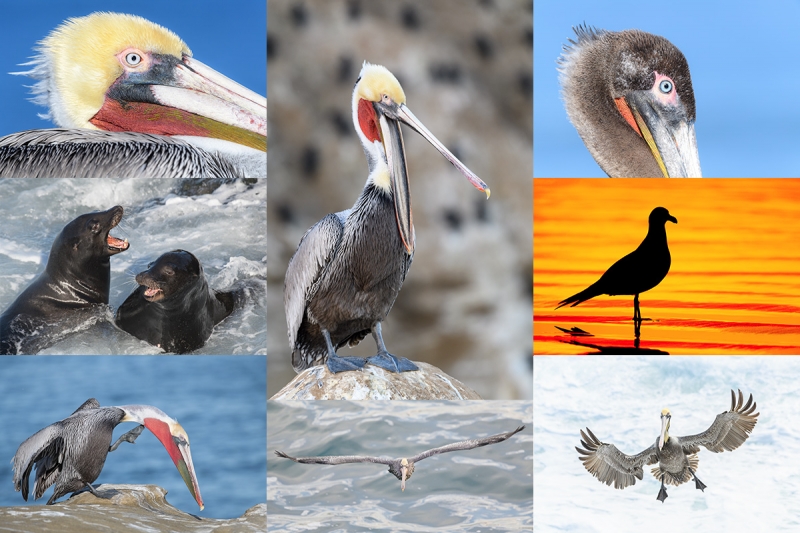














Love the combined image. I often like less-than-BAA-perfect head angles, but in this case it’s the adult’s startling blue eye that really makes the image for me. Needs a little touch-up, as on the enlarged version there’s a small divot on the upper breast (a smooth area lighter than the surrounding feathers) where the imported head met the base image. Visible at 100%, but even clearer at 200%.
Good point on that blue eye, Cliff! See my e-mail on the divot.
with love, artie
Artie
I have never seen a cormorant click its head up and down like yours can 🙂
I agree with David P. 🙂 on Sues comment omg!
I’d also love to see what Jeff W commented on combining all the different ones together might be a new Art ??
Kosher isn’t that a dill pickle?
Artie i lack the necessary skills to combine the heads or tails or even wing repair, i am still struggling on photoshop as i have yet to render an image.
I do however like the photo without the new head and tail work!
PS- i didn’t fall off a cliff to capture amazing fireworks last evening, i was sitting firmly on a slight hillside using my tripod, I learned my lesson the first time falling and requiring fire rescue to propel down the cliff to lower me to the river, so no more cliff diving for me 🙂
Always with love b
Thanks for your erudite comments. I am glad that you did not fall off the cliff (again). And I do not like dill pickles, kosher or otherwise.
with much love, artie
Not kosher in my humble opinion. Planning trips and snapping off pics to get a perfect shot is what it is all about. I’d rather have the special moment and memory in my mind from being at the location than doctor up a shot to make a more artistic picture. I’m like David P. as I clearly admit That I don’t have the skills or software to go there. I’d rather see it, enjoy the moments and try to capture the beauty as I’m seeing it. A little beach cleanup is perhaps one thing but why not take 3 or 4 different birds like a Snowy’s feet, Ghb pony tail, blue heron body, white morph head and night heron eyes and make art. Ridiculous or maybe something to copyright?
Ridiculous to me. Sorry to be “Debbie downer” on this one.
Thanks, Jeff, for your honest response. For me, the natural history of the moment has been preserved in the optimized image; therefore, I am not breaking any laws — dietary or otherwise 🙂
with love, artie
Is it Kosher? That depends on the intent of the photograph and it would be frowned upon for photojournalism and most photo contests. As an artistic expression, I think it is lovely image which you composited masterfully. BTW, I preferred image #1 from yesterday for all the reasons mentioned. Happy 4th!
No capital needed for kosher 🙂 You explain well why I call it BIRDS AS ART 🙂
With love, artie
The composite is of course stronger with the adult head about perfect in position and clarity but I am not quite clear about why you felt the need for tail doctoring… The only problem with combining the two is that (for me) I like to know that it is a combination. Your photos (and those of your students) are pretty much unattainable for me, so it is instructive (and hopeful) to know that sometimes it takes even you two shots to get one good one .
On another subject, could you please elaborate more on reducing the angle of declination and using the longer lens…I might need a diagram to understand this better. Thanks.
On Bird Photographers.Net, I am the self-appointed captain of the Head Angle Police. Thus the need for two perfect head angles 🙂
I say often that in behavior and action situations, the new gear is so good that on occasion beginners may create a better image than a professional (with a bit of instruction and with the camera set up properly).
As for the angle of declination, let’s try this: If you are standing and you walk up to a tame subject and point a 200mm lens down at it, you will have a steep angle of declination. If you move back and shoot the same subject the same size in the frame with a 600mm lens, the angle of declination will be much shallower, and the perspective much more pleasing.
with love, artie
Thanks for the explanation — I understand it and appreciate you taking the time to write it out!
Hi, Artie. Sue Jarrett’s comment made my day. Thank you, Sue Jarrett.
You ask if combining the images is kosher for me, or not. It’s not kosher FOR ME, because I don’t have the skills or the desire to do it. But IMO, it’s not important if it’s kosher for me; what’s important is whether it’s kosher FOR YOU. (Obviously it would not be kosher if you weren’t honest about it, but that’s not the case and that’s not you.) If I didn’t know better I’d probably prefer the combined image, but the original is so good that I’d be extremely happy if it were mine. In any case, it’s very skillfully done, mazeltov.
Many thanks, Dr. Fish. And yes, kosher for me.
with love, artie
Both images Brandt’s Cormorant begging chick in nest/head of adult are well made and cute and interesting and the second image is more interesting with him clicking his head up and down.
Of course, Sue.
with love, a
Hey Artie,
I love the edited version.
Thanks, Tony. Me too 🙂
with love, artie